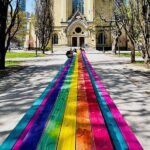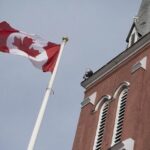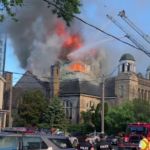Blog Post
‘Burn It All Down’ — Scapegoating the Church for Society’s Sins
By Jonathon Van Maren
For months, a steady stream of news stories in Canada has highlighted a historic injustice: Indian residential schools. From 1883 until 1996, Indigenous children were taken from their families and sent to government institutions for re-education. The explicitly-stated intention of these schools was to “kill the Indian in the child.”
Thus, they were removed from their parents, families, and communities. Their families were forbidden to visit them. Often, parents were not told where their children were. This was a century-long policy of state-perpetrated family breakup. It was a wicked policy, regardless of the intention.
This history is relatively well-known, but the injustice has been underscored once again by the rediscovery of unmarked child graves on school grounds. The death rate in these schools was high due to disease and malnutrition. At some schools, the mortality rate was 10 times higher than that of the white population.
Children were subjected to barbaric punishments, sexual abuse, and solitary confinement. They were disciplined for speaking their own language. And when thousands of them died, most of them were not sent home to their families even in death. Their parents never saw them again. Instead, they were buried outside the schools.
It is these graves that are reigniting the conversation about residential schools in Canada.
Because churches were commissioned by the Canadian government to run some of these schools — the Catholic Church, United Church, and Anglican Church — there has been an outbreak of attacks against churches. To date, over 50 Canadian churches have been burned, partially destroyed, or vandalized with red paint. Some of these churches were heritage buildings. Many have been Indigenous churches serving Indigenous parishioners. Many others have been from denominations (like a British Columbian Coptic church) that had nothing to do with the residential school system.
The arsonists, however, do not seem to care. Culpability is not the point — targeting churches is. These acts of arson and vandalism have been universally condemned by Indigenous leaders. Video footage of some attacks show white activists splashing paint on churches before racing away. It seems likely, at this point, that progressive activists are hijacking a historical discussion to vent their rage against Christianity. Not a single act of arson has been attributed to an aggrieved residential school survivor. Every act has been condemned, often angrily, by Indigenous people who recognize that their pain is being used as a political weapon by leftist grifters.
It is undoubtedly true that leftist activists are hijacking historic injustices to further their agendas. This has always been the case. It is happening in the United States with the issue of historic injustice against African Americans, as well. It is also a reason that conservatives should be cautious.
Too often, the response of conservatives to discussions surrounding historical grievances is dismissal. A key reason for this is the extent to which progressives are often the ones driving the narrative. The conservative reaction is thus a knee-jerk response to leftist moralizing — which can mean that we miss the underlying point. This is especially true when racial discussions are accompanied by church-burnings, statue-smashing, and Marxist solutions.
READ THE REST OF THIS COLUMN AT THE STREAM








